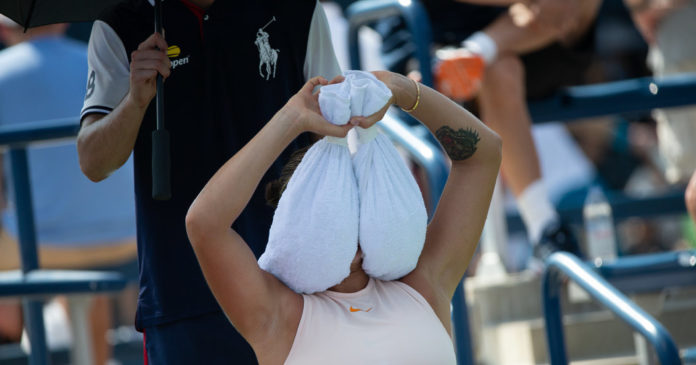Andrea Petkovic really didn’t want to leave the Louis Armstrong Stadium court for a heat break after the second set of her match against Jelena Ostapenko on Tuesday. But she didn’t want to spend the 10-minute timeout in the sun while Ostapenko cooled off, so Petkovic headed for a private, air-conditioned room under the building — which turned out to be a mistake.
She drank some cold water and draped herself in ice towels, changed her drenched socks and wet shoes. She was not permitted to talk to a coach, and didn’t have time to open a David Foster Wallace novel that was packed in her bag.
“When I came back out, it felt like five billion degrees,” Petkovic said. “Next time, I would stay out there, chill on the bench.”
Petkovic lost her serve immediately after returning to the court and fell, 6-4, 4-6, 7-5, in a meandering 2 hour 18 minute match on Tuesday that taxed players and spectators alike. Everybody suffered at least a bit throughout the day: By 1 p.m., the temperature was 95 degrees, and the 47 percent humidity created a feel-like temperature of 105 degrees. That measurement was significantly higher on the heat-retaining hardcourts.
By the time the evening matches started at 7 p.m., four players on the men’s side — Ricardas Berankis, Leonardo Mayer, Stefano Travaglia and Mikhail Youzhny — had retired, citing the heat. Berankis called conditions downright perilous.
“They should have canceled the matches. It was not healthy,” Berankis said. “We are fit, but this was too much. It is dangerous out there. The ATP doesn’t have a heat rule but they should stop the matches. They will not make a change until someone dies.”
Though the ATP, which governs men’s tennis, has no such rule, the U.S. Open’s tournament referee, Brian Earley, announced an Extreme Heat Policy for the Open on Tuesday, allowing the men to take a 10-minute break between the third and fourth sets, provided at least one player asks for it. Since 1992, the WTA, which oversees the women’s game, has allowed players to take such a rest between the second and third sets when the heat stress index is at least 86 degrees.
This was the first time that the U.S. Open offered the men such a break.
“We mimic what the two tours do, but we have discretion in our rules, similar to seeding,” said Chris Widmaier, a spokesman for the United States Tennis Association.
The ATP has stubbornly avoided a definitive heat policy, despite requests from some of its top players. Three years ago, during another heat wave at the U.S. Open, Stan Wawrinka lobbied for such a rule change: Why, he asked, did the women get a break after two sets while the men had none over five sets?
“That’s just a question I always asking myself,” he said at the time.
Sometimes, the men have found ways to create their own recovery time. During his first-round victory over Grigor Dmitrov on Monday, with no heat policy in effect, Wawrinka sought and received a rather nebulous injury timeout. Asked about that break after the match, Wawrinka offered no details about the problem and just spoke generally about the frailty of his body.
Novak Djokovic took full advantage of the precedent and used the 10-minute break to help survive his four-set win over Marton Fucsovics. Both players, Djokovic said, spent the time “naked in the ice baths next to each other.” During the heat breaks, all players are escorted by an official and cannot receive coaching or medical treatment.
The heat policy will most likely be in place again on Wednesday, when conditions may actually be hotter. Widmaier said the Open also would consider closing the roofs over the Ashe and Armstrong stadiums because of the heat, a move that has been resisted here because it might be considered unfair to the players toiling on the other courts. On Tuesday, many players on those outside courts did not have access to air-conditioned rooms during their 10-minute breaks.
It remained unclear what more the tournament could do about such conditions. CoCo Vandeweghe suggested that the new 25-second shot clock should be abandoned, because she required toweling off after every point. Venus Williams, who trains at 7 a.m. in Florida, said she should have altered her own practice times to adjust to such brutal conditions.
“Maybe I should start training at noon,” Williams said.
For Ostapenko, the 10-minute break between sets was enough to restore her focus and revitalize her body.
“Actually, I think it helped me a lot,” Ostapenko, 21, said. “I went to the bathroom and changed the outfit for the new one to be more fresh and just stayed in air conditioning for 10 minutes. Then I went on court and broke her serve straightaway.”
Petkovic was not quite so positive about the whole experience. She said the New York humidity made her joints swell and exacerbated her nagging injuries. Asked what Open officials might have done to counteract the heat, Petkovic offered one idea.
“I would have appreciated somebody, preferably a handsome man, carrying me corner to corner on the court,” she said.
Source : NYtimes












